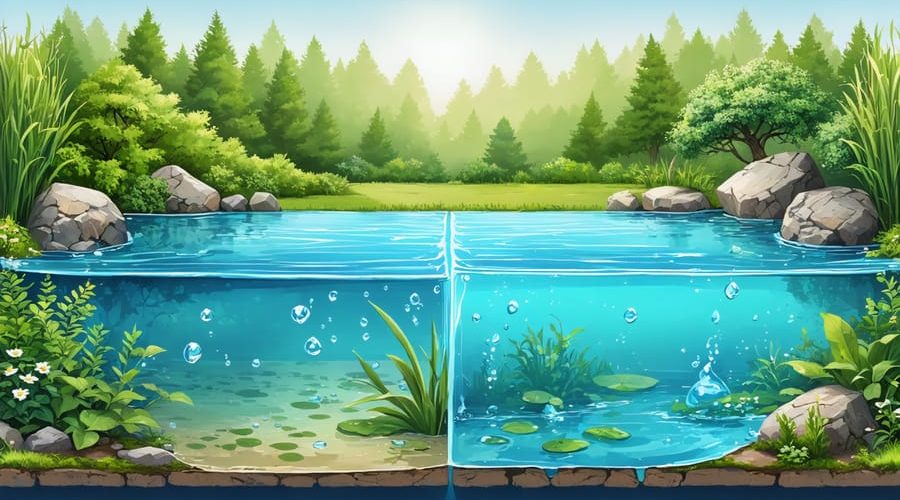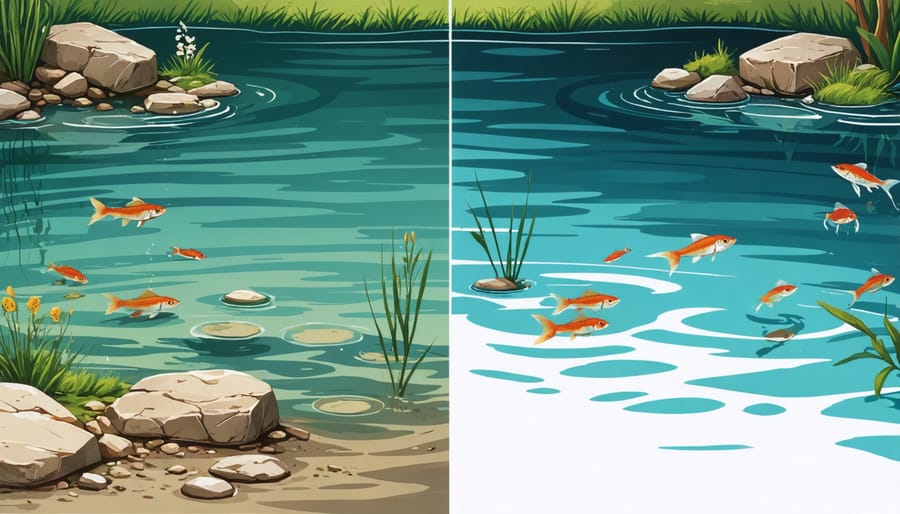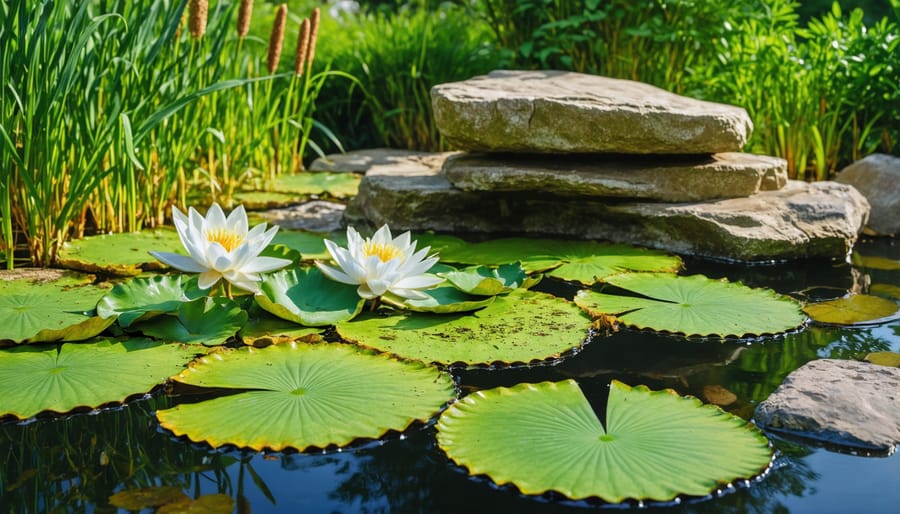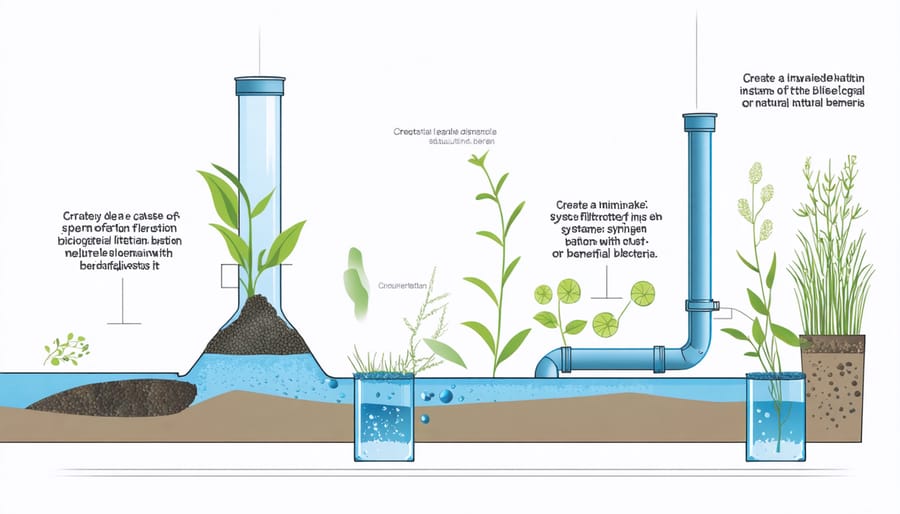
Natural Water Softening: Transform Your Pond Without Harsh Chemicals
Transform your home’s water quality while protecting the environment with modern eco-friendly water softeners. These innovative systems eliminate harsh chemicals and excessive salt discharge while maintaining crystal clear water throughout your household. Unlike traditional water softeners that release brine into local waterways, eco-friendly alternatives use advanced technologies like template-assisted crystallization (TAC) and magnetic water conditioning to naturally reduce scale buildup. These sustainable solutions not only prevent mineral deposits in your pipes and appliances but also preserve beneficial minerals that traditional softeners typically remove. Perfect for environmentally conscious homeowners, these systems require minimal maintenance, use significantly less water, and operate without electricity or salt – making them both cost-effective and planet-friendly. Whether you’re dealing with hard water issues or simply wanting to make your home more sustainable, eco-friendly water softeners offer a responsible solution that benefits both your household and the environment.
Why Your Pond Needs Eco-Friendly Water Softening

Signs of Hard Water in Your Pond
Spotting hard water in your pond isn’t as tricky as you might think. The most obvious sign is a white, chalky residue around the edges of your pond or on rocks and decorative features. You might also notice that your pond plants aren’t thriving as they should, with leaves appearing dull or yellowish due to mineral buildup.
If you’re running a pond fountain or waterfall, scale deposits might start collecting on these features, potentially affecting their performance. Fish behavior can be another indicator – if they’re rubbing against surfaces more than usual, it could be due to mineral irritation on their scales.
Keep an eye on your pond equipment too. Hard water often leaves deposits in pumps and filters, making them work harder and less efficiently. Your water might appear cloudy or have a slightly greenish tinge, especially after topping up with fresh water.
Testing your pond water regularly with a simple water hardness kit can confirm your suspicions and help you take action before these issues become more serious. Remember, catching these signs early makes treatment much easier and more effective.
The Environmental Cost of Traditional Softeners
Traditional water softeners, while effective at reducing hard water, come with significant environmental drawbacks. These systems typically use sodium chloride or potassium chloride, releasing high concentrations of salt into our water systems. When this treated water makes its way into ponds, lakes, and streams, it can harm aquatic plants and disrupt the delicate balance of these ecosystems.
The brine discharge from conventional softeners can increase salinity levels in freshwater habitats, making it difficult for native species to thrive. Fish, amphibians, and aquatic insects are particularly sensitive to these changes. Additionally, the salt can accumulate in soil over time, affecting plant growth and potentially contaminating groundwater sources.
Many traditional softeners also waste significant amounts of water during their regeneration cycle, sometimes up to 150 gallons per week. This not only increases water bills but puts unnecessary strain on local water resources. The energy required to run these systems adds to their environmental footprint, contributing to higher carbon emissions.
For pond owners and nature enthusiasts, these environmental costs make it crucial to consider more sustainable alternatives that can effectively treat hard water while protecting our precious aquatic ecosystems.
Natural Water Softening Solutions
Biological Filtration Systems
Biological filtration systems offer a natural and sustainable approach to water softening by harnessing the power of beneficial bacteria and aquatic plants. These living filters work together to create a balanced ecosystem that naturally removes minerals and impurities from your water.
At the heart of biological filtration are beneficial bacteria colonies that break down harmful compounds and help maintain optimal water conditions. These microscopic helpers naturally colonize filter media like lava rock, ceramic rings, or bio-balls, creating a thriving microscopic ecosystem that processes minerals and organic matter.
Aquatic plants play an equally important role in this natural filtration process. Plants like water hyacinth, cattails, and rushes actively absorb excess minerals, including calcium and magnesium – the primary culprits behind hard water. These plants not only help soften water but also add visual appeal to your pond or water feature.
Creating a biological filtration system is surprisingly simple. Start by installing a dedicated filter chamber filled with bio-media, then add carefully selected aquatic plants in floating baskets or along the edges of your water feature. Over time, beneficial bacteria will naturally colonize the system, creating a self-sustaining cycle of filtration.
The beauty of biological filtration lies in its low maintenance requirements and environmental benefits. Unlike traditional water softeners, these systems don’t require salt or chemicals, making them an truly eco-friendly choice for conscious homeowners.
Water-Softening Aquatic Plants
Nature has provided us with some remarkable water-softening champions in the form of aquatic plants. These natural water conditioners not only add beauty to your pond or water feature but also help reduce water hardness through their natural filtering abilities.
Cattails are among the most effective water-softening plants, using their extensive root systems to absorb excess minerals and heavy metals from hard water. These hardy plants are easy to maintain and provide excellent filtration throughout the growing season.
Water lilies, besides being stunning additions to any water garden, actively absorb calcium and magnesium – the primary minerals responsible for hard water. Their large floating leaves also provide shade, helping maintain balanced water conditions.
Hornwort, a submerged plant, is particularly effective at softening water through its ability to extract dissolved minerals directly from the water column. This plant requires minimal care and can grow in various water conditions.
Eelgrass and Canadian waterweed are other excellent choices, known for their superior mineral-absorption capabilities. These plants work continuously to filter water and can significantly reduce hardness levels over time.
For best results, combine different types of these aquatic plants in your water feature. Remember to maintain proper plant density – typically covering about 60% of your water surface – to achieve optimal water-softening benefits while maintaining a healthy ecosystem balance.
Regular trimming and maintenance of these plants ensure they continue working effectively as natural water softeners while keeping your water feature looking beautiful and well-maintained.

Mineral-Based Solutions
Nature provides several remarkable minerals and rocks that can effectively soften water without harmful chemicals. One of the most popular natural solutions is zeolite, a volcanic mineral with an amazing ability to trap hard water minerals through ion exchange. Think of zeolite as nature’s water filter, working tirelessly to reduce calcium and magnesium levels in your water.
Another powerful option is tourmaline, which not only helps soften water but also adds beneficial minerals. When combined with other innovative filtration materials, these natural stones create a comprehensive water treatment system that’s gentle on the environment.
Limestone and coral media are also excellent choices for natural water softening. These calcium-rich materials work by gradually releasing minerals that help balance water chemistry. For the best results, consider creating a mixed-media filter bed using different combinations of these natural materials.
Green sand, derived from glauconite mineral deposits, is another eco-friendly option that’s gaining popularity. It’s particularly effective at removing iron and manganese while helping to soften water naturally. These mineral-based solutions typically last longer than traditional salt-based softeners and require minimal maintenance – just an occasional backwash to keep them working efficiently.
Remember, while these natural solutions might work more gradually than chemical alternatives, they provide a sustainable, environmentally responsible approach to water softening that’s perfectly aligned with nature’s own processes.
Implementation and Maintenance

Setting Up Your Natural System
Setting up your eco-friendly water softener is a straightforward process that you can complete in just a few hours. Start by choosing an accessible location near your main water line, preferably before it branches off to other areas of your home. You’ll want a spot with enough space for both the softener unit and the salt-free mineral tank.
Begin by shutting off your main water supply and draining the pipes. Install a bypass valve if one isn’t already present – this will allow you to maintain your water supply during future maintenance. Next, connect the inlet and outlet ports of your eco-friendly softener to your home’s plumbing system using flexible water connectors.
For salt-free systems, install the pre-filter first to remove sediment and protect your system. Then, connect the mineral tank following the manufacturer’s guidelines. Many natural softeners come with clear labels indicating water flow direction – make sure to align these correctly.
If your system includes a backwashing feature, connect it to a nearby drain. Unlike traditional softeners, eco-friendly versions typically use minimal water for cleaning cycles. Once everything is connected, slowly turn the water back on and check all connections for leaks.
Finally, let the water run for about 5-10 minutes to flush the system and remove any installation debris. Your eco-friendly water softener is now ready to provide naturally softened water throughout your home.
Monitoring and Adjusting
Regular maintenance of your eco-friendly water softener ensures optimal performance and longevity. It’s essential to monitor water conditions at least monthly using simple testing kits available at most hardware stores. Check your water’s hardness levels before and after treatment to ensure your system is working effectively.
Pay attention to salt levels if you’re using a salt-based eco-friendly system. Most modern units have indicators showing when it’s time to replenish, but it’s good practice to check manually every few weeks. For salt-free systems, inspect the filter cartridges or media quarterly and replace them as recommended by the manufacturer.
Watch for changes in water pressure or flow rate, as these can indicate scaling or system inefficiency. If you notice a decrease in soap lather or scale building up on fixtures, your system might need adjustment or maintenance. Keep a maintenance log to track patterns and optimize your softener’s performance.
Consider seasonal adjustments too – water hardness can vary throughout the year, especially if you’re using well water. During periods of heavy water usage, you might need to adjust regeneration frequency. Most importantly, address any issues promptly to maintain your system’s eco-friendly benefits and prevent unnecessary water waste.
As we’ve explored throughout this article, eco-friendly water softeners offer a sustainable solution for homeowners seeking to improve their water quality while protecting our environment. These natural alternatives not only effectively tackle hard water issues but also contribute to sustainable water management practices that benefit both our homes and the planet.
By choosing environmentally conscious water softening methods, you’re reducing salt discharge into our waterways, minimizing energy consumption, and decreasing your carbon footprint. The benefits extend beyond environmental impact – you’ll enjoy softer water that’s gentler on your skin, clothes, and appliances while avoiding the harsh chemicals found in traditional softeners.
Remember that maintaining your eco-friendly water softener is typically simpler and more cost-effective in the long run. Whether you’ve opted for a magnetic system, template-assisted crystallization, or other natural alternatives, you’re making a choice that aligns with both personal comfort and environmental responsibility.
Looking ahead, the future of water treatment lies in these sustainable solutions. As more homeowners embrace eco-friendly options, we’re collectively contributing to cleaner waterways and healthier ecosystems. Your choice to go green with water softening isn’t just about improving your home’s water quality – it’s about being part of a larger movement toward environmental stewardship.
Take the next step in your sustainable living journey by implementing these natural water softening solutions. Start small, monitor the results, and adjust as needed. Every household that switches to eco-friendly water treatment brings us closer to a future where clean, soft water doesn’t come at the environment’s expense. Your commitment to natural water softening solutions today helps ensure a healthier planet for generations to come.
